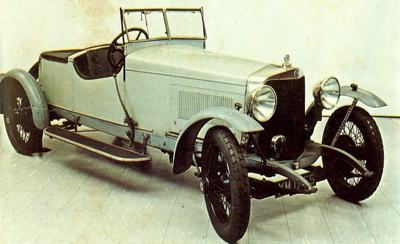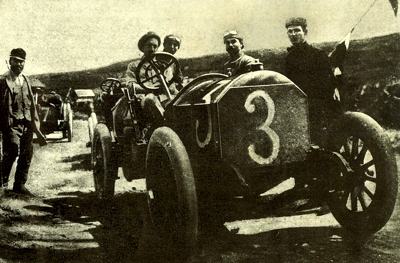When you start researching Italian car history, the name of Ceirano seems to be everywhere: it was Giovanni Ceirano's factory which was taken over by the Fiat company in 1899 to build motor cars; Matteo Ceirano was behind Itala; Giovanni was later responsible for SCAT and Rapid cars before World War 1 and for Ceirano and Newton-Ceirano after it, while in 1906 Matteo had founded the Societa Piemontese Automobili in Turin, aided by Michele Ansaldi.
The first SPA cars were little different from the contemporary Italas - big, rugged machines of 24 and 60 hp with, unusually, shaft drive: by 1907 the range had grown to include a 60hp six, and a 30/35 hp six, and a light 15/24hp four, as well as the 40hp four. They were imported into England by H. E. Hall & Co, of Riding House Street, London W, who showed all four as polished chassis at the Olympia Motor Show in November 1907.
Ernesto Ceirano and Frencesco Ciuppa
The following year another of the Fratelli Ceirano, Ernesto, took third place in the
Targa Florio in a SPA, while Frencesco Ciuppa was equally successful in two years later in another in 1909. In 1910 the British agency for SPA was taken over by Thomas Green & Son, Limited, an old-established firm of iron-founders and engineers of Smithfield Ironworks, Leeds - at the time Green & Son were better known as manufacturers of lawnmowers.
At first they offered the 15/20hp SPA, which had a frame (as was usual at the time) of channel section steel, well cambered, and generously flared as to the flanges of the side members in rear of the in-sweep by the dashboard. The longitudinals were smartly upswept over the back axle, and the rear member had its flanges produced to form clip brackets, taking the butt ends of the three-quarter elliptical rear springs.
'The engine, which is supported directly from the frame proper, was of the mono bloc design, and made a very neat appearance beneath the bonnet, while the carburettor, which had two jets, and was water-jacketed, was placed on the right of the engine, with the gas leads formed in the casting and passing between the pairs of cylinders. It had a vertically-acting throttle pedal, and was also lever operated with a vacuum damped automatic air valve over.
The
exhaust lead was also cast with the cylinders, so that the engine had no outside pipes whatever, which made for a very clean job ... no
radiator fan is provided, but in lieu thereof a large flywheel was cast with vaned arms, which served to induce a strong draught through the
radiator and engine space. A multi-disc clutch conveyed the drive from the engine to the gear box, a neat, flexible and easily-detached joint intervening. The price of the 15/20 in the UK, with side-entrance coachwork, was £385: also available was a twin-cylinder 10 hp (£295 in chassis form) offered only during the 1910 season, a 16/20 which seemed to be identical to the 15/20 in everything save price (£395 in chassis form against £335), a 20/25 hp (£485) a 25130 hp (£555), a 40/50 hp (£685) and two big sixes, a 30/40hp (£685) and 60/ 70hp (£975).
 1922 SPA 23S 20 hp 2724cc.
1922 SPA 23S 20 hp 2724cc.
 Baron Ciuppa pictured at the end of the 1909 Targa Florio in his winning SPA 28/40hp.
Baron Ciuppa pictured at the end of the 1909 Targa Florio in his winning SPA 28/40hp. |
Some motoring journals at the time claimed the SPA's were the best cars coming out of Italy. At the 1911 Olympia Show they exhibited only 16/20 hp SPAs, which seemed to be woefully over-bodied: Seven seater Cabriolet, five seats inside and one next to driver. Price £550. Seven seater Cabriolette, five seats alongside driver, one special let-down seat made concealed in door when not in use. All-enclosed dickey seat behind for two persons. Price £550.
The SPA All-Enclosed Limousine
The six-cylinder models were dropped for the model year 1913, and the range was of the 12/15 hp, 16/20 hp, 25/30 hp and an all-new 50 hp with a long-stroke 7.6-litre engine. The long-suffering 16/20 was endowed for Olympia with an All-Enclosed Limousine which reached new heights of cumbersomeness: 'To carry five or seven passengers; front can be shut off when owner wishes his chauffeur to drive, and two removable chairs inside'.
An increase in stroke transformed the 16/20 into the 18/25 for 1914, but otherwise the range was unchanged: the last of the old model were exhibited at the 1913 Olympia Show, where the public were treated to the annual spectacle of three 16/20s groaning under the various heavy coupe, saloon and landaulette coachwork placed on the chassis. After the war, two models were offered, the 2.3 litre Tipo 23, which seemed to be little more than an updated version of the old 16/20, and the Tipo 24, of similar design but having six cylinders and 4.4 litres. There was a sporting variant of the four, the Tipo 23S, with a 75 mph top speed, but the most exciting post-war model appeared in 1922, in the shape of the 30/40 hp Super Sports.
The SPA Super Sports had the same cylinder dimensions as the six, but was equipped with twin overhead camshafts and four valves per cylinder; tubular connecting rods, light alloy pistons and steel cylinder liners completed the internal specification of the engine, which was endowed with twin carburettors. Front-wheel
brakes were standard, and a Teutonically vee-shaped
radiator was normal wear. Driving one of these fine six-cylinder SPAs, Beria D'Argentina Won the Aosta-Grand St Bernard hill climb, and the model was also able to take the first two places in its class in the 1924 3000 km Alpine Cup contest, an extremely competitive race. In 1925, SPA became a component of the mighty Fiat empire. Car production ceased almost immediately, but the marque has steadily continued to gain new fame in the commercial vehicle and engineering fields, into the 1970s.



